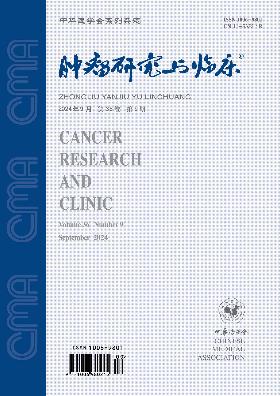Study on the mechanism of inhibiting invasion of human laryngeal squamous cell carcinoma Hep-2 and TU212 cells after the downregulation of miRNA-106b
Q4 Medicine
引用次数: 0
Abstract
Objective To investigate the effect of miRNA-106b (miR-106b) on human laryngeal squamous cell carcinoma Hep-2 and TU212 cells and its mechanism. Methods Hep-2 and TU212 cells were divided into miR-106b inhibitory sequence transfected group (the experimental group), miR-106b competitive negative sequence transfected group (the negative control group) and non-intervention group (the blank group). The inhibitory effect of miR-106b inhibitory sequence on the expression of miR-106b was verified by using reverse transcription quantitative polymerase chain reaction (qRT-PCR). Whether phosphatase and tensin homolog (PTEN) was the target gene of miR-106b was analyzed by using bioinformatics and luciferase report vector. PTEN small interfering RNA (siRNA) was used to inhibit the expression of PTEN in Hep-2 and TU212 cells. Transwell method and Western blot were used to detect the change of invasion ability of Hep-2 and TU212 cells after miR-106b silencing or the PTEN intervening, and the expression change of PTEN, epithelial cadherin and vimentin. Results The relative expression levels of miR-106b in Hep-2 and TU212 cells in the experimental group were 0.110 ± 0.037 and 0.074 ± 0.009, respectively, which were lower than those in the negative control group (1.013±0.059 and 1.035±0.062, respectively; all P < 0.05). In Transwell experiments, the number of invasive cells in each field of Hep-2 and TU212 cells in the experimental group was less than that in the negative control group [(37.09±4.02) vs. (95.65±4.77), (29.16±2.49) vs. (103.19±6.08), all P < 0.05]. The bioinformatics analysis results showed that 3'-UTR region of PTEN mRNA was complementary to 3'-UTR region of miR-106b. Dual-luciferase reporter system analysis showed that the luciferase reporter activity of wild-type PTEN gene transfected with miR-106b was decreased to (22.84±2.68)%, and that of mutant PTEN gene transfected with miR-106b was almost unchanged [(92.08±3.44)%], and the difference was statistically significant (P < 0.001). The expression level of PTEN protein of Hep-2 and TU212 cells in the experimental group was higher than that in the negative control group. Transwell method showed that the number of invasive cells in each field of Hep-2 and TU212 cells in the experimental group with the inhibition of PTEN expression was more than that in the experimental group without the inhibition of PTEN expression [(65.08±3.57) vs. (26.72±2.58), (57.38±4.96) vs. (31.81±2.97), all P < 0.05]. Western blot showed that the expression level of epithelial-cadherin was up-regulated and vimentin was down-regulated of Hep-2 and TU212 cells in the experimental group with the inhibition of PTEN expression. Conclusions The human laryngeal squamous cell carcinoma Hep-2 and TU212 cell miR-106b can influence the downstream invasion-related protein of PTEN and change the cell invasion ability through the targeted regulation of PTEN expression. Key words: Laryngeal neoplasms; Carcinoma, squamous cell; Neoplasm invasiveness; RNA interference; miRNA-106b; Phosphatase and tensin homolog下调miRNA-106b后抑制人喉癌Hep-2和TU212细胞侵袭的机制研究
目的探讨miRNA-106b(miR-106b)对人喉鳞状细胞癌Hep-2和TU212细胞的作用及其机制。方法将Hep-2和TU212细胞分为miR-106b抑制性序列转染组(实验组)、miR-106b竞争性负序转染组(阴性对照组)和非干预组(空白组)。通过逆转录定量聚合酶链反应(qRT-PCR)验证了miR-106b抑制序列对miR-106b表达的抑制作用。利用生物信息学和荧光素酶报告载体分析了miR-106b的靶基因是否为磷酸酶和紧张素同源物(PTEN)。PTEN小干扰RNA(siRNA)用于抑制PTEN在Hep-2和TU212细胞中的表达。采用Transwell法和Western印迹法检测miR-106b沉默或PTEN干预后Hep-2和TU212细胞侵袭能力的变化,以及PTEN、上皮钙粘蛋白和波形蛋白的表达变化。结果实验组Hep-2和TU212细胞中miR-106b的相对表达水平分别为0.110±0.037和0.074±0.009,低于阴性对照组(分别为1.013±0.059和1.035±0.062;均P<0.05),实验组Hep-2和TU212细胞各领域的侵袭细胞数均少于阴性对照组[(37.09±4.02)vs.(95.65±4.77),(29.16±2.49)vs。双荧光素酶报告子系统分析显示,转染miR-106b的野生型PTEN基因的荧光素素酶报告子活性降至(22.84±2.68)%,而转染miR-106b的突变型PTEN几乎没有变化[(92.08±3.44)%],实验组Hep-2和TU212细胞PTEN蛋白的表达水平高于阴性对照组。Transwell法显示,抑制PTEN表达的实验组Hep-2和TU212细胞各领域的侵袭细胞数均高于未抑制PTEN的实验组[(65.08±3.57)vs.(26.72±2.58),(57.38±4.96)vs在抑制PTEN表达的情况下,实验组Hep-2和TU212细胞的波形蛋白上调和下调。结论人喉鳞状细胞癌Hep-2和TU212细胞miR-106b可通过靶向调节PTEN的表达,影响PTEN下游侵袭相关蛋白,改变细胞侵袭能力。关键词:喉肿瘤;癌,鳞状细胞;肿瘤侵袭性;RNA干扰;miRNA-106b;磷酸酶和紧张素同源物
本文章由计算机程序翻译,如有差异,请以英文原文为准。
求助全文
约1分钟内获得全文
求助全文
来源期刊

肿瘤研究与临床
Medicine-Oncology
CiteScore
0.10
自引率
0.00%
发文量
7737
期刊介绍:
"Cancer Research and Clinic" is a series of magazines of the Chinese Medical Association under the supervision of the National Health Commission and sponsored by the Chinese Medical Association.
It mainly reflects scientific research results and academic trends in the field of malignant tumors. The main columns include monographs, guidelines and consensus, standards and norms, treatises, short treatises, survey reports, reviews, clinical pathology (case) discussions, case reports, etc. The readers are middle- and senior-level medical staff engaged in basic research and clinical work on malignant tumors.
 求助内容:
求助内容: 应助结果提醒方式:
应助结果提醒方式:


